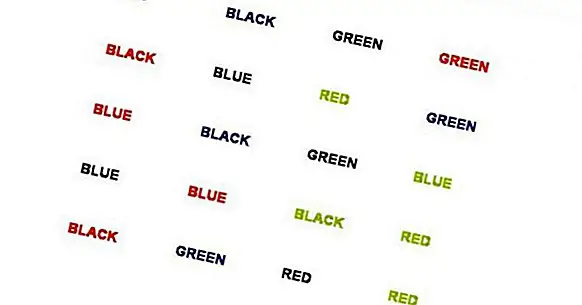Stroop test: this evaluates the attentional and inhibitory capacity
The human being tends, through learning, to habituate to perform certain actions. Eating, writing, reading or going by bike: all are processes that initially require our full attention, but that we end up automating.
Usually this automation helps us save resources, but the truth is that sometimes can be disadvantageous. It is what happens when we are asked to do a task in which stimuli appear that elicit the automated response, but asking us to do something else. We must stop the automatism to carry out the real task. One way to measure this interference is the Stroop test.
- Related article: "Psychology of color: meaning and curiosities of colors"
The Stroop test
The Stroop test is a psychological test linked especially to neuropsychology that allows to measure the level of interference generated by the automatisms in the accomplishment of a task.
Also called Test of Colors and Words, was developed by Golden with the intention of assess aspects such as selective attention and inhibitory control , when observing that the people who knew how to read tended to take longer the color in which the words were written than in reading the name of said colors (because they had more automated reading). It also allows to assess the processing speed
The duration of the application of this test is relatively short , around five minutes, and is designed for people between seven and eighty years of age.
Although it consists of three phases, the best known and most widely used part is based on the reading of the word that designates a color written in a different color to the one it expresses, so that the subject has to inhibit the automatic response of reading in order to be able to correctly designate the color with which the words are written.
- Related article: "Selective attention: definition and theories"
The three phases or tasks
Throughout the Stroop test a total of three different tasks are done , by means of three sheets in which five columns of 20 elements appear. Each of the tasks is carried out during a certain time (for example, forty-five seconds), with the correct answers for the subsequent evaluation.
1. Reading of words
First, the subject is given a list with the names of three colors (red, blue and green) written in black, and he is asked to read them.
2. Color identification task
The second task is the identification of colors , in which the observed is given a list in which symbols appear without colored meaning. The subject is asked to identify and name the color of each of the elements.
3. Interference task
Finally, the third and most representative task of the Stroop test is based on the interference principle, offering the subject a list of words with the name of the previously mentioned colors, but this time written with a color different from the one the word refers to . For example, the word BLUE written in red appears. The subject must name the color in which each element is written.
Interpretation of the Stroop test
The data collected through the Stroop test must be analyzed. The successes that the subject has had during the test or by the time it takes to react to the stimulation , paying attention to what is reflected in each of the slides or tasks.
In the third of the tests we can observe the reaction time of the subject, which indicates aspects such as the interference produced by different aspects of the same stimulation , the capacity to resist it, the management of cognitive and attentional resources or the perseveration and repetition of behaviors.
- Maybe you're interested: "The 15 types of attention and what are their characteristics"
Effect of interference
You can calculate the estimated approximate score that a subject should get in the third test, from the product quotient of the words read in the first test by the color of the second divided by its sum.
If we subtract from the actual score obtained in the interference task the estimated score, we can see if the person correctly inhibits the response (values greater than 0, positive) or if there are significant interference problems (if it is a negative value). In general, the majority of the population scores between 10 and -10.
But nevertheless, it is possible that this estimate is skewed if the subject has a very low or very high level of reading experience (the value of the answers in the first test the performance in the third may vary depending on whether we are more or less used to reading)
Possible indications of brain damage
In addition, each of them can give important information regarding brain functioning, although the test in question does not allow a specific interpretation if there are a lot of errors in all of them.
In the task of reading tend to appear errors in those subjects with problems in the left hemisphere, specialized in language. Especially in the case of injuries in the supramarginal and angular turns .
On the other hand, the task of naming colors allows detecting if there are problems in the right hemisphere.
The interference task usually shows lower results than the previous ones in almost the whole population, but sometimes it can be observed the existence of perseveration in making mistakes that could be indicating an affectation in the frontal or in the basal ganglia.
- Related article: "Parts of the human brain (and functions)"
Area of application
The main scope of application of this test is the neuropsychological evaluation. And is that allows to obtain a measure of attention and of executive functions such as inhibitory control of behavior.
Specifically, it is often used to observe the effects of a brain injury or assess whether there is involvement of certain brain areas such as the frontal lobe. In addition to injuries, it can assess the executive functions of patients with dementias such as Alzheimer's disease and Huntington's disease.
Although not as usual as in the previous cases, it can also be used in the assessment of the abilities of people with different mental disorders, such as schizophrenia or, more frequently, ADHD.
Bibliographic references:
- Golden, C.J. (2005). Test of colors and words (Stroop). Madrid: TEA Editions.
- Almond, M.T. (2012). Psychotherapies CEDE Preparation Manual PIR, 06. CEDE: Madrid.



















